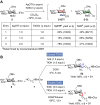Unraveling the promoter effect and the roles of counterion exchange in glycosylation reaction
- PMID: 37851803
- PMCID: PMC10584349
- DOI: 10.1126/sciadv.adk0531
Unraveling the promoter effect and the roles of counterion exchange in glycosylation reaction
Abstract
The stereoselectivity of glycosidic bond formation continues to pose a noteworthy hurdle in synthesizing carbohydrates, primarily due to the simultaneous occurrence of SN1 and SN2 processes during the glycosylation reaction. Here, we applied an in-depth analysis of the glycosylation mechanism by using low-temperature nuclear magnetic resonance and statistical approaches. A pathway driven by counterion exchanges and reaction byproducts was first discovered to outline the stereocontributions of intermediates. Moreover, the relative reactivity values, acceptor nucleophilic constants, and Hammett substituent constants (σ values) provided a general index to indicate the mechanistic pathways. These results could allow building block tailoring and reaction condition optimization in carbohydrate synthesis to be greatly facilitated and simplified.
Figures








Similar articles
-
Mechanistic insight into benzylidene-directed glycosylation reactions using cryogenic infrared spectroscopy.Nat Synth. 2024;3(11):1377-1384. doi: 10.1038/s44160-024-00619-0. Epub 2024 Jul 26. Nat Synth. 2024. PMID: 39524531 Free PMC article.
-
Characterization of Elusive Reaction Intermediates Using Infrared Ion Spectroscopy: Application to the Experimental Characterization of Glycosyl Cations.Acc Chem Res. 2022 Jun 21;55(12):1669-1679. doi: 10.1021/acs.accounts.2c00040. Epub 2022 May 26. Acc Chem Res. 2022. PMID: 35616920 Free PMC article. Review.
-
The influence of acceptor nucleophilicity on the glycosylation reaction mechanism.Chem Sci. 2017 Mar 1;8(3):1867-1875. doi: 10.1039/c6sc04638j. Epub 2016 Nov 9. Chem Sci. 2017. PMID: 28553477 Free PMC article.
-
The Experimental Evidence in Support of Glycosylation Mechanisms at the SN1-SN2 Interface.Chem Rev. 2018 Sep 12;118(17):8242-8284. doi: 10.1021/acs.chemrev.8b00083. Epub 2018 May 30. Chem Rev. 2018. PMID: 29846062 Free PMC article. Review.
-
Glycosyl Oxocarbenium Ions: Structure, Conformation, Reactivity, and Interactions.Acc Chem Res. 2021 Jun 1;54(11):2552-2564. doi: 10.1021/acs.accounts.1c00021. Epub 2021 Apr 30. Acc Chem Res. 2021. PMID: 33930267 Free PMC article. Review.
Cited by
-
Development of a Cryogenic Flow Reactor to Optimize Glycosylation Reactions Based on the Active Donor Intermediate.Org Process Res Dev. 2024 Jul 19;28(7):2819-2826. doi: 10.1021/acs.oprd.4c00140. Epub 2024 Jun 11. Org Process Res Dev. 2024. PMID: 39372330 Free PMC article.
-
The Stereoselectivity of Neighboring Group-Directed Glycosylation Is Concentration-Dependent.J Am Chem Soc. 2025 Feb 19;147(7):5808-5818. doi: 10.1021/jacs.4c14402. Epub 2025 Feb 5. J Am Chem Soc. 2025. PMID: 39907188 Free PMC article.
-
Characterization of elusive rhamnosyl dioxanium ions and their application in complex oligosaccharide synthesis.Nat Commun. 2024 Mar 13;15(1):2257. doi: 10.1038/s41467-024-46522-2. Nat Commun. 2024. PMID: 38480691 Free PMC article.
-
Mechanistic insight into benzylidene-directed glycosylation reactions using cryogenic infrared spectroscopy.Nat Synth. 2024;3(11):1377-1384. doi: 10.1038/s44160-024-00619-0. Epub 2024 Jul 26. Nat Synth. 2024. PMID: 39524531 Free PMC article.
-
Synthesis of Campylobacter jejuni capsular oligosaccharides and identification of a potential O-antigen against campylobacteriosis.Sci Adv. 2025 Apr 11;11(15):eadu2318. doi: 10.1126/sciadv.adu2318. Epub 2025 Apr 9. Sci Adv. 2025. PMID: 40203105 Free PMC article.
References
-
- Y. Maki, R. Okamoto, M. Izumi, Y. Kajihara, Chemical synthesis of an erythropoietin glycoform having a triantennary N-glycan: Significant change of biological activity of glycoprotein by addition of a small molecular weight trisaccharide. J. Am. Chem. Soc. 142, 20671–20679 (2020). - PubMed
LinkOut - more resources
Full Text Sources

